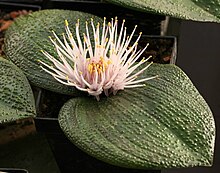Massonia pustulata, the blistered massonia, is a species of flowering plant in the family Asparagaceae, subfamily Scilloidiae, native to the Western Cape of South Africa. Growing to 10 cm (3.9 in) tall and broad, it is a small bulbous perennial with two horizontal, opposite leaves, and virtually stalkless cream or pink flowers in winter. The stamens are longer than the perianth, giving the flower the appearance of a rounded, spiky brush-head.[3] The deep "pock marks" on the leaves give the plant its common name, as well as the specific epithet pustulata.
| Massonia pustulata | |
|---|---|

| |
| Scientific classification | |
| Kingdom: | Plantae |
| Clade: | Tracheophytes |
| Clade: | Angiosperms |
| Clade: | Monocots |
| Order: | Asparagales |
| Family: | Asparagaceae |
| Subfamily: | Scilloideae |
| Genus: | Massonia |
| Species: | M. pustulata
|
| Binomial name | |
| Massonia pustulata | |
| Synonyms | |
| |
In temperate zones it requires protection as it does not survive being frozen. Its small size makes it a suitable subject for a pot under glass.[3] It has been given the Royal Horticultural Society's Award of Garden Merit.[4][5]
The Massonia genus of plants is named for Scottish botanist and gardener Francis Masson, who was Kew Gardens' first plant hunter.
References
edit- ^ "Massonia pustulata Jacq". International Plant Names Index. Retrieved 4 April 2018.
- ^ a b "Massonia pustulata Jacq". The Plant List. Retrieved 4 April 2018.
- ^ a b "Massonia pustulata - Plant of the Month Dec 2015". The Alpine Garden Society. Retrieved 4 April 2018.
- ^ "RHS Plantfinder - Massonia pustulata". Retrieved 4 April 2018.
- ^ "AGM Plants - Ornamental" (PDF). Royal Horticultural Society. July 2017. p. 64. Retrieved 4 April 2018.
-
Fruits